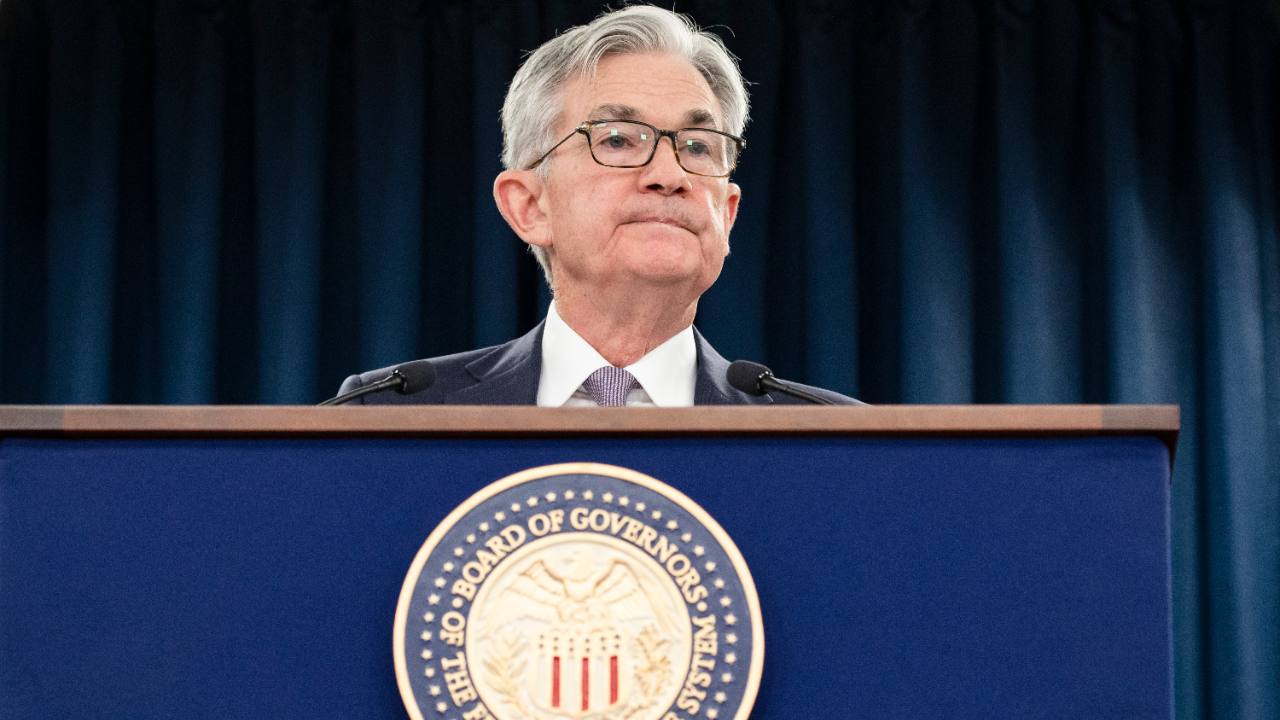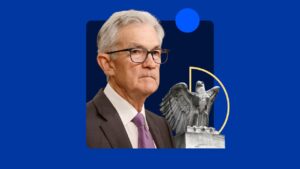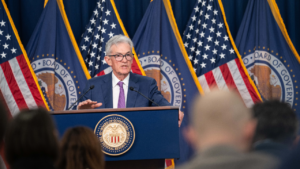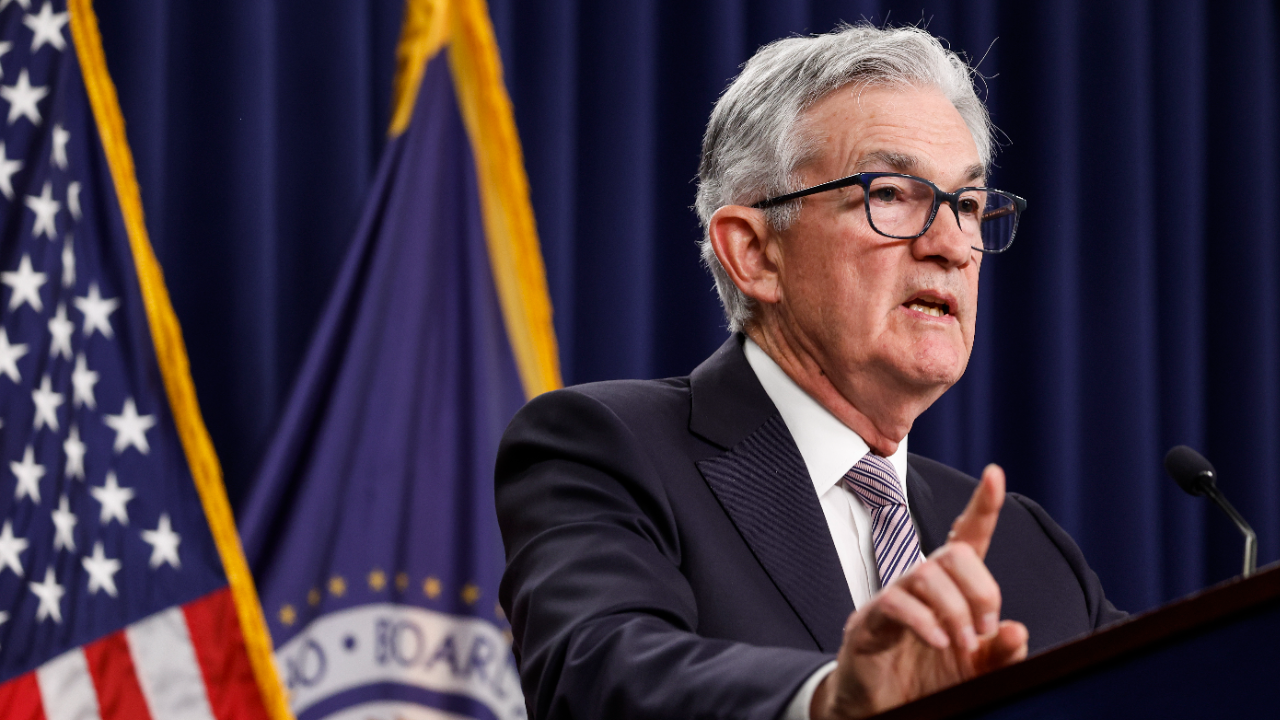Federal Reserve raises interest rates for first time since 2018

For the first time in nearly four years, the Federal Reserve increased the price of borrowing money by a quarter point on Wednesday and announced plans to raise rates six more times this year, a widely expected yet monumental decision that will have ripple effects across every aspect of Americans’ financial lives.
The Federal Open Market Committee (FOMC) set 0.25-0.50 percent as the new target range for the federal funds rate — a key benchmark borrowing rate that influences anything from auto loans and credit card rates to yields on certificates of deposit (CDs) and savings accounts. Officials previously slashed that rate to zero at an emergency meeting in March 2020, when the coronavirus pandemic first cratered the U.S. economy.
Fed officials also projected a 1.75-2 percent fed funds rate by the end of 2022 despite fresh inflation and growth risks after Russia’s invasion of Ukraine. That would mean seven total rate hikes this year, assuming the U.S. central bank moves in quarter-point increments.
“The implications for the U.S. economy are highly uncertain, but in the near term, the invasion and related events are likely to create additional upward pressure on inflation and weigh on economic activity,” officials said in their post-meeting statement.
- Fed raises rates to target range of 0.25-0.5 percent.
- Officials penciled in at least six more rate hikes for 2022, assuming central bankers move in quarter-point increments.
- Policymakers sharply downgraded their 2022 economic growth forecasts to 2.8 percent from 4 percent.
- Fed sees 4.3 percent inflation and 3.5 percent unemployment in 2022.
What it means for: Mortgage rates | Savers | Borrowers | Investors
The FOMC “anticipates that ongoing increases in the target range will be appropriate,” officials added.
The decision is just as much a vote of confidence in the economy’s recovery from the devastating outbreak as it is a signal of concern about surging inflation. Americans’ purchasing power has sharply receded amid supply chain bottlenecks, resilient demand and a tight labor market coming out of the pandemic. Consumer prices climbed 7.9 percent on an annual basis in February 2022, a 40-year high. Back in January 2021, prices were up just 1.4 percent.
The Fed’s move is the biggest step taken yet to fight off that inflation. The Fed also confirmed that it will end a key bond-buying plan in March that added almost $4.7 trillion to the money supply, helping send mortgage rates to record lows and fueling a housing boom.
“By raising interest rates, the Federal Reserve has begun the process of unwinding their pandemic-era stimulus measures in an effort to tame inflation,” says Greg McBride, CFA, Bankrate chief financial analyst. “This isn’t a one-and-done but the start of a series of rate hikes for the remainder of this year and well into next.”
The Fed’s rate hike: What it means for you
Mortgages and refinance rates
For the most part, homeowners won’t feel any immediate impact from the Fed’s move. That’s partially because most mortgage rates come with fixed rates, meaning their interest payments are fixed for the entire life of the loan.
It’s also because mortgage rates follow the 10-year Treasury yield more than the fed funds rate. Both, however, are still influenced by the same forces. Higher rates are all but expected this year — and in many cases, the cost of financing a home is already on the rise — as investors price in the likelihood of higher inflation and a hawkish U.S. central bank.
“Mortgage rates have already increased one full percentage point since the beginning of the year, adding to the pressures of limited inventory and sky-high home prices facing home buyers,” McBride says.
The refinance clock is also ticking — and homeowners risk missing out on the prime opportunity to lock in a lower rate the longer they wait. Yet, even if you missed out on refinancing your mortgage during last year’s record lows, you still might be able to find a better deal than what you’re currently paying. In a rising-rate environment, shopping around for the best deal is more important than ever. Grab offers from multiple lenders, and compare them with your current rate.
Savers
If you have any amount of money stashed away in a savings account, you might be breathing a sigh of relief after the Fed’s rate hike. A higher fed funds rate typically leads banks to also lift yields. If history is any guide, depository institutions follow suit almost immediately.
But for savers, all of their problems won’t just go away overnight. Americans are contending with the highest levels of inflation that many have ever seen, underscoring the importance of finding the best place to park your cash. Online banks are often able to offer more competitive rates than traditional brick-and-mortar ones, and many accounts are still offering a yield 10 times the national average.
As always, having an emergency fund is an important aspect of every financial plan, even in high-inflationary environments.
Borrowers
Consumers with debt — especially on a high-interest rate credit card — will want to prioritize paying their obligations off fast. Credit card rates are almost certainly going to rise with every Fed rate hike, and some might see their annual percentage rates (APRs) climb at a faster pace than others. Credit card companies typically charge borrowers a margin on top of the prime rate, which is generally 3 percentage points higher than the fed funds rate.
Even in a rising-rate environment, one factor influences how cheaply you can borrow even more than the Fed — your credit history and score. Lenders tend to reserve the best deals for those who have the best track record of on-time payments and low utilization ratios. If you’re hoping to avoid feeling the pinch of higher interest rates, make boosting your credit score a goal for your personal finances.
“Consumers can expect higher borrowing costs to be just another form of inflation, with rates for credit cards and home equity lines of credit notching higher in the next month or so,” McBride says.
Investors
Zero rates and an accommodative bond-buying program were like candy to investors. As the Fed continues to take the punchbowl away this year, markets are sure to have a bumpy ride. Tune out any day-to-day volatility and focus on the long term. The Fed’s hoping to achieve a long economic expansion and stabilize inflation, all of which would bode well for your portfolio.
But the higher the Fed has to take rates, the more risks of a recession grow. U.S. central bankers know from past experience that the main way to tame inflation is to lift rates rapidly. The concern, however, is that officials might have to tighten financial conditions so much that it could lead to an economic slowdown — or worse, recession.
Recessions aren’t always as devastating as the coronavirus pandemic or the Great Recession before it, but consider crafting your own gameplan. That should include thinking about what you’d do if you faced job loss. That could be revisiting your budget to make sure you’re living within your means, ramping up your emergency fund, seeking out new training or maintaining connections with your network to increase your employability.
With Fed’s first rate hike in the books, officials eye six more this year
Investors are pricing in a rapid series of hikes at an even more aggressive pace this year.
The largest share sees a 2-2.25 percent fed funds rate by the end of this year, which would mean eight total rate hikes in 2022, according to CME Group’s FedWatch. The Fed has been that active before. In 2005, the Fed raised rates eight times — a year when consumer inflation averaged at 3.3 percent, according to the Bureau of Labor Statistics.
Still, officials aren’t revealing that aggressive of a hand just yet. In addition to penciling in seven total possible increases for 2022, officials see the fed funds rate climbing to a target range of 2.75-3 percent by 2023. That’s slightly higher than the Fed’s so-called neutral rate of interest, meaning rates would technically be in restrictive territory by the end of next year.
“The American economy is very strong and well positioned to handle tighter monetary policy,” Fed Chair Jerome Powell said at a post-meeting press conference. “I saw a committee that is acutely aware of the need to return the economy to price stability.”
Inflation
The Fed’s path all comes down to inflation. Price pressures have remained much more stubborn than officials first anticipated in 2021, especially in the sectors prone to pandemic-related disruptions, such as gasoline, energy, furniture and used vehicles.
But inflation has also worsened in areas that aren’t directly tied to the virus. Prices in February rose by the fastest annual rates on many items that consumers regularly buy. Among them were service-based sectors, such as car repair costs and meals out at restaurants — adding to fears that inflation in motion tends to stay in motion.
“We’ve had price stability for a very long time and maybe come to take it for granted,” Powell said. “But now we see the pain.”
Even factoring in seven rate hikes this year, the Fed still sees elevated inflation persisting through 2024. For 2022, Fed officials penciled in 4.3 percent headline inflation, up from 2.6 percent. They also see inflation excluding food and energy — two baskets of goods that have surged since Russia’s invasion of Ukraine — rising 4.1 percent in the year, up from 2.7 percent. After that, Fed policymakers see 2.7 percent inflation in 2023 and 2.3 percent inflation in 2024.
“It’s an indication that they feel they’re a little bit behind the curve and are playing catch up,” says Steve Skancke, chief economic advisor at Keel Point and a former Treasury Department staffer. “That’s certainly remarkable, but given where unemployment is and job growth, it’s maybe even a little bit of a conservative view.”
Ukraine, soaring energy prices and COVID-19
But the Fed’s forecasts look even more uncertain, especially amid uncertainties about the conflict between Russia and Ukraine, as well as new pandemic-related lockdowns in China. Before Russia’s invasion, Powell said that the Fed expected inflation to peak in the first quarter of 2022. Oil prices have soared more than 30 percent since Russia’s invasion and prices at the pump hit a national record high on March 11, according to AAA.
“We expect inflation to remain high through the year and then come down more sharply next year,” Powell said.
But the situation could also hit economic growth. Reflecting those concerns, the FOMC sharply downgraded its forecasts for gross domestic product (GDP) — the broadest scorecard of the U.S. economy — to 2.8 percent from 4 percent.
Even so, officials don’t see that weighing on joblessness. Policymakers in their March 2022 projections penciled in a 3.5 percent unemployment rate for the year ahead.
All of those factors illustrate the complicated economic backdrop within which Fed officials are having to set rates.
For right now, investors are giving the Fed room to be aggressive, given that they’re already pricing in interest rates of around 2 percent this year, according to Lindsey Bell, chief markets and money strategist at Ally.
“I do think that’s the rate at which you are going to start to see a slowdown in economic activity,” Bell says. “Call it the worst-case scenario. For us to get more aggressive than that is more unlikely than likely. So to me, the risk for the market is potentially to the upside.”
Balance sheet
Beyond the Fed’s rate hike path, also up in the air is the Fed’s balance sheet plans, including whether officials will soon start to let bonds roll off its portfolio once they reach maturity. Both can have a restrictive effect on growth, and the Fed hasn’t ever tinkered with the two tools in quick succession of each other.
Powell said officials made “excellent progress” at establishing a game plan for trimming its near $9 trillion bond portfolio, adding that it would announce those plans at “a coming meeting.”
“Every meeting is a live meeting,” Powell said. “We’re going to be looking at evolving conditions. If we do conclude that it would be appropriate to move more quickly to remove accommodation, then we’ll do so.”






